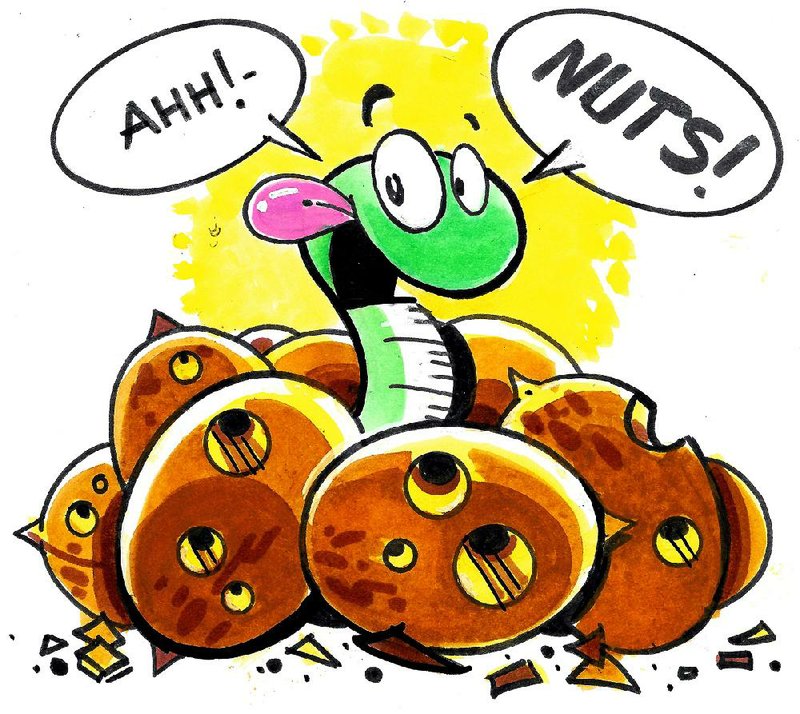Q Back in the summer I Googled spraying for worms in pecans. It said to spray in August and September with 5 ounces of Sevin in 10 gallons of water under the drip line of the trees, to do it several times through the two months and put some stickum on the tree trunks. It stated that the worms come out from the ground and climb the trunk and bore into the nuts. I did as they said and still had about 50 percent nuts with worms that had bored through the husks and into the nuts. I thought that next year I would just spray the nuts with the Sevin throughout those months. What are your thoughts on doing this and skipping the ground spraying?
A I visited with our pecan expert and here is her answer: There are different types of worm pests in pecans, and so the first step would be to identify the culprit. I am going to guess it is two things, weevil and hickory shuck worm. For hickory shuck worm control, you would spray a BT (Bacillus thuringiensis) product starting in July. I would make two applications 10 days apart. I would also get circle traps up by July 1 to begin monitoring for weevils. You can send infested nuts to your county Cooperative Extension Service office for pest identification if needed. There is a great fact sheet on circle trap construction (see bit.ly/2CtDonN) or you can buy them from Great Lakes IPM. It sounds like you are trying to prevent pecan weevil infestation using ground spraying. I have heard from others who tried this and it does not work. The weevil pupae lurk 16-18 inches in the ground, so ground sprays are not effective. About 80 percent of weevils emerge from their soil cell and then crawl up the trunk of the tree, the other 20 percent fly up to the canopy. I suggest that homeowners put circle traps on trees to intercept the 80 percent that crawl up the trunk. This is a good alternative to spraying, and you will have minimal damage. But if you want to maximize nut production by spraying the tree directly with Sevin or a synthetic pyrethroid, start when the first weevil is captured in the circle trap and repeat thereafter when more are trapped. Sprays tend to begin in July/August but are very weather dependent, hence the importance of monitoring. One more point from me -- pecan trees are huge trees at maturity and thorough spraying can be difficult for home gardeners. Thus, I say for home gardeners, consider the pecan as a shade tree, and if you get quality nuts that is a bonus.
Q We have been having a lot of really low temperatures. When should I consider covering plants for protection and which plants need it? If I'm supposed to cover plants while below 32 degrees, do I uncover them during the day?
A Unless you are growing winter vegetables, covering plants in the middle of winter is usually not needed. Winter protection is usually called for during the transition seasons -- as plants are breaking dormancy in the spring and a hard freeze is predicted. Azaleas, Japonica camellias, etc., are plants that sometimes need a little extra protection in late winter or early spring as they are coming out of dormancy. Clear, still nights are more of a problem than overcast, windy nights. Covering usually gives you a few degrees of protection. Removing the cover or leaving it on depends on the material you use. Plants can stay covered for days if the material is porous. If you are using plastic coverings and the sun comes out and the daytime temps go up, venting them will be needed. If you are growing winter vegetables, most are usually good to around 26-28 degrees, depending on what is being grown. I usually cover with a large cardboard box or inverted large flower pot as needed.
Q When can hellebores be divided and transplanted? Any special tips or technique would also be appreciated. I'd like to share one with a friend. Thank you for your help and for the wonderful articles you write for the paper. I have learned so much. There are now more successes than failures, which makes gardening a joy.
A I never recommend dividing the mother hellebore plant since there is usually one crown radiating out. There usually are daughter plants or seedlings around the mother plant. Those can be moved in the spring or in the fall. Glad you are having gardening success. It makes you want to garden even more. Happy New Gardening Year!
Janet B. Carson is a horticulture specialist for the University of Arkansas Cooperative Extension Service. Write to her at 2301 S. University Ave., Little Rock, Ark. 72204 or email her at
jcarson@arkansasonline.com
HomeStyle on 01/06/2018
